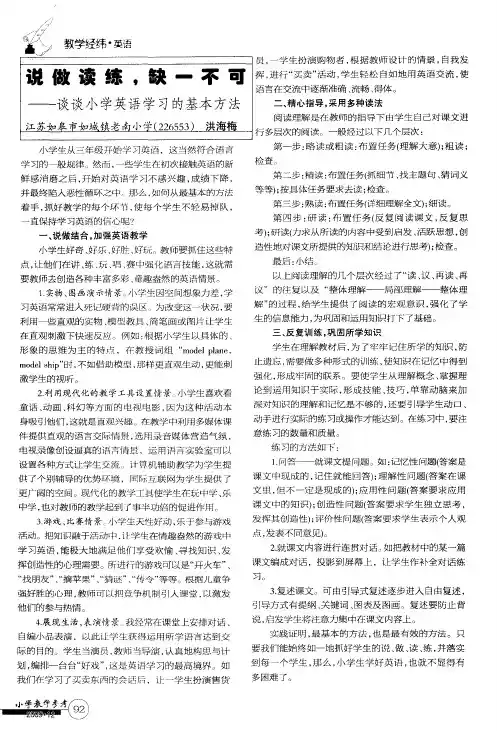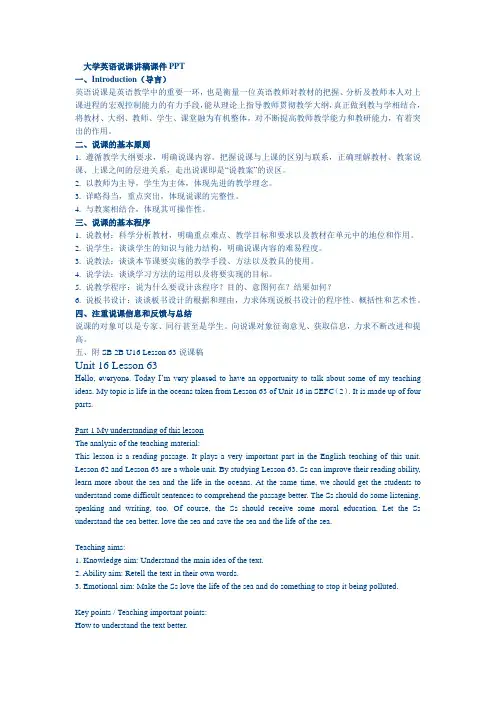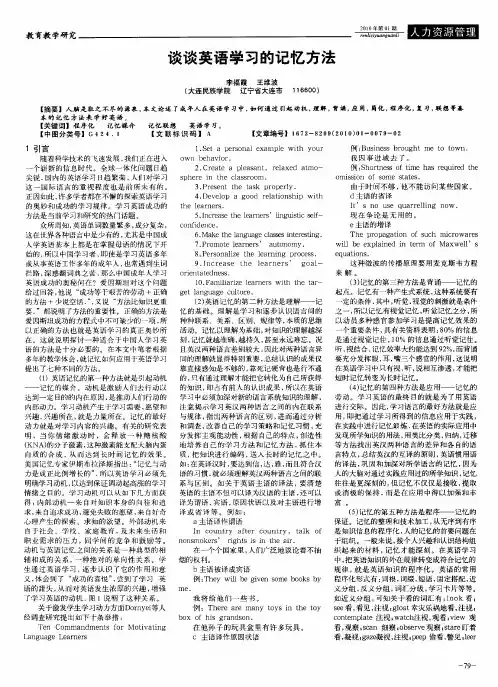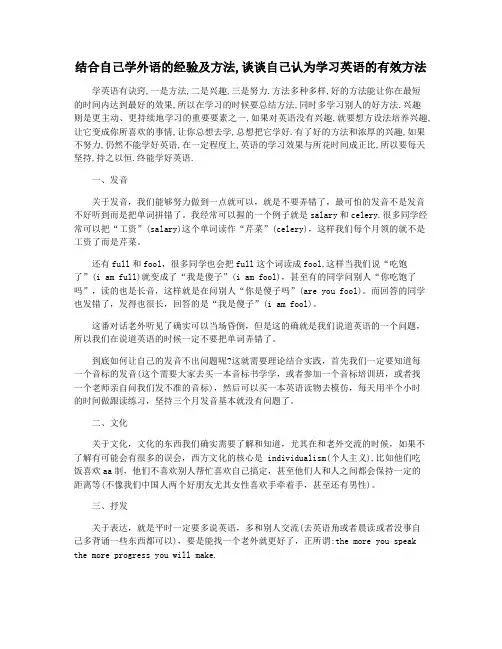谈谈英语学习方法.ppt
说做读练,缺一不可—谈谈小学英语学习的基本方法

着 手 , 好 教学的每个环 节 , 每个学 生不轻易掉 队 , 抓 使
一
直 保 持 学 习英 语 的 信 心 呢 ?
一
Байду номын сангаас第 四 步 : 读 : 置 任 务 f 复 阅 读 课 文 , 复 思 研 布 反 反
考 )研 读 ( 求从 所读 的 内 容 中 受到 启发 、 跃 思 想 , ; 力 活 创
更 广 阔 的 空 间 。现 代 化 的教 学 工 具 使 学 生 在 玩 中学 、 乐
中 学 , 对 教 师 的教 学 起 到 ,事 半 功倍 的促 进 作 用 。 也
3游戏 、 赛情 景 ? . 比 小学 生 天 性 好 动 . 于 参 与游 戏 乐
活 动 。把 知 识 融 于 活动 中 , 学 生在 情 趣 盎 然 的游 戏 中 认
深对知识的理解和记忆是不够的 , 要引导学生动 口 、 还
动 手 进行 实 际 的 练 习或 操 作 才能 达 到 。在 练 习中 , 注 耍
意 练 习 的数 量 和 质 量 。 练 习的 方 法 如 下 :
件 提供 直观 的语 言 交 际情 景 , 用 录 音 媒 体 营 造 气氛 , 选 电视 录 像 创 设 逼 真 的 语 言 情 景 ,运 用 语 言实 验 室 可 以 设 置 各 种 方 式 让 学 生 交 流 .计算 机 辅 助 教 学 为学 生 提
“ 朋友 ” “ 苹果 ” “ 找 、摘 、 猜谜 ” “ 、 传令 ” 等 根 据 儿 童 争 等 强好 胜 的 心 理 , 教师 可 以把 竞 争机 制 引 入 课 堂 , 激 发 以
2 课 文 内 容 进行 连 贯 对 话 。 把教 材 中 的 某 一篇 就 如
课文 编 成 对话 ,投 影 到 屏 幕 上 ,让 学 生 作 补 全 对 话 练
大学英语说课讲稿课件PPT

大学英语说课讲稿课件PPT一、Introduction(导言)英语说课是英语教学中的重要一环,也是衡量一位英语教师对教材的把握、分析及教师本人对上课进程的宏观控制能力的有力手段,能从理论上指导教师贯彻教学大纲,真正做到教与学相结合,将教材、大纲、教师、学生、课堂融为有机整体,对不断提高教师教学能力和教研能力,有着突出的作用。
二、说课的基本原则1. 遵循教学大纲要求,明确说课内容。
把握说课与上课的区别与联系,正确理解教材、教案说课、上课之间的层进关系,走出说课即是“说教案”的误区。
2. 以教师为主导,学生为主体,体现先进的教学理念。
3. 详略得当,重点突出,体现说课的完整性。
4. 与教案相结合,体现其可操作性。
三、说课的基本程序1. 说教材:科学分析教材,明确重点难点、教学目标和要求以及教材在单元中的地位和作用。
2. 说学生:谈谈学生的知识与能力结构,明确说课内容的难易程度。
3. 说教法:谈谈本节课要实施的教学手段、方法以及教具的使用。
4. 说学法:谈谈学习方法的运用以及将要实现的目标。
5. 说教学程序:说为什么要设计该程序?目的、意图何在?结果如何?6. 说板书设计:谈谈板书设计的根据和理由,力求体现说板书设计的程序性、概括性和艺术性。
四、注重说课信息和反馈与总结说课的对象可以是专家、同行甚至是学生。
向说课对象征询意见、获取信息,力求不断改进和提高。
五、附SB 2B U16 Lesson 63说课稿Unit 16 Lesson 63Hello, everyone. Today I’m very pleased to hav e an opportunity to talk about some of my teaching ideas. My topic is life in the oceans taken from Lesson 63 of Unit 16 in SEFC(2). It is made up of four parts.Part 1 My understanding of this lessonThe analysis of the teaching material:This lesson is a reading passage. It plays a very important part in the English teaching of this unit. Lesson 62 and Lesson 63 are a whole unit. By studying Lesson 63, Ss can improve their reading ability, learn more about the sea and the life in the oceans. At the same time, we should get the students to understand some difficult sentences to comprehend the passage better. The Ss should do some listening, speaking and writing, too. Of course, the Ss should receive some moral education. Let the Ss understand the sea better, love the sea and save the sea and the life of the sea.Teaching aims:1. Knowledge aim: Understand the main idea of the text.2. Ability aim: Retell the text in their own words.3. Emotional aim: Make the Ss love the life of the sea and do something to stop it being polluted.Key points / Teaching important points:How to understand the text better.Teaching difficult points:1. Use your own words to retell the text.2. Discuss the pollution of the sea and how to save the sea.Something about the Ss:1. The Ss have known something about the sea and sea life through the Internet and other ways.2. They are lack of vocabulary.3. They don’t often use English to express themselves and communicate with others.4. Some Ss are not active in the class because they are afraid of making mistakes.Part 2 My teaching theories, methods and aidsBefore dealing with this lesson, I’ll do my best to carry out the following theories: Make the Ss the real masters in class while the teacher himself acts as director;Combine the language structures with the language functions; Let the students receive some moral education while they are learning the English language.Teaching method:Double activities teaching methodQuestion-and-answer activity teaching methodWatch-and-listen activityFree discussion methodPair work or individual work methodTeaching aids:1. a projector2. a tape recorder3. multimedia4. the blackboardPart 3. Teaching steps / proceduresI have designed the following steps to train their ability of listening, speaking, reading and writing, especially reading ability.The entire steps are:Greetings, Revision, Lead-in and preparation for reading, Fast reading(scanning), Listening, Intensive reading, Preparation for details of the text, Consolidation, Discussion, HomeworkStep 1 GreetingsGreet the whole class as usual.Step 2. Revision1. Ask students some questions to revise the last lesson(show them on the screen).a. How much salt do the oceans contain per thousand parts of water?(35 parts of salt. 3.5% by weight)b. What is coral? Why are corals not found in deep water?c. Why is the Dead Sea called the Dead Sea?2. Check the homework(made a survey about the sea or sea life by surfing the Internet or asking for help from other people). Through this part we can consolidate what they studied yesterday, communicate with others about their survery results and prepare for the new lesson.Step 3. Lead-in and preparation for readingShow them some pictures and let them talk each other, and then use the pictures about sea and life in the oceans to learn new words, for example, Antarctica, huge whale, sperm whale, squid and so on. Purpose: Arouse the students’ intere st of study.Bring in new subject: Life in the oceans.Step 4. Fast readingRead the passage as quickly as they can. I show the questions on the screen and let them get the main idea of each paragraph:1. Why can living things live in such oceans around the Antarctica?2. What does the whale feed on?3. What is the difference between the sperm whale and other whales?Method: Read the text individually, use question—and—answer activity.Purpose: Improve the students’ reading ability.Understand the general idea of each paragraph.Step 5. Listening(book closed)1. Listen to the tape then do an exercise(wb page 90, part 1)2. True or false exercise.(on the screen)Train the Ss’ listening ability and prepare for later exercises.Step 6. Intensive readingRead the passage carefully again and answer some detailed questions on the screen.1. How much does a whale eat at a time?2. Do all the whales feed on small fish?3. How deep can a sperm whale dive?It is also called depth reading or study reading. It means reading for detailed information.Purpose: Further understand the text (Train further reading ability)to find out some different sentences and details of the text.Step 7. Preparation for details of the text on the screen1. ...its heart slows to half its normal speed.slow-v. to become / make slower.2. ing sound wavePresent participle used as adverbial.3. provide sth. for sb.provide sb. with sth.4. at a time: each time5. grow to a length of...Purpose: Train the Ss’ ability of understanding and using laguage.Step 8. Consolidation1. Find out the topic sentences.2. Retell the passage according to the topic sentences.Purpose: I want to know if my students understand the whole text really and if they master what I mean to tell them in this class. What’s more, I want to let them have the ability of introducing and analyzing expression. At the same time, I will write down the topic sentences on the blackboard according to what the students find, so they can retell it easily.Step 9. DiscussionShow them some pictures about the polluted sea and many living things which are in danger and ask them: What are their opinions about it? In order to let them have free choice, I give them another topic: The sea is being polluted. What should they do?Purpose: I mean to give them emotional education. I give them multi-media pictures to arouse their interest of study and their love for life. I mean to make them realize: The sea is in danger!I teach them to do their best to help it and do something from now on. Everyone should do something to love and protect our home.Step 10. HomeworkWrite an article Saving the sea. I want to improve the ability of their writing. At the same time, train the ability of do-it-yourself and looking up the information by themseleves.Part 4. Blackboard designUnit 16 Lesson 63Topic Sentences:1. Some living things can live in Antarctica.(what)2. The whale feeds on small fish.(what)3. The sperm whale feeds on squid.(difference)Discussion:1. The whales are in danger. What’s your opinion about it?2. The sea is being polluted. What should we do?In my opinion, the blackboard design can reflect the teacher’s ability of mastering the text and leading the students to master the text easily.In this text, the design is not easy to write. I write the topic sentences on the blackboard in order to tell the students that this is of the importance in this class. The discussion is of the difficulty.I want to make the design inductive, instructive and artistic.。
谈谈英语学习的记忆方法

4. veop goo r l to hi De l a d e a i ns p w ih t
t e r r . he l a ne s
5.nc e s he la n r I ra e t e r e s’ln  ̄ si ef ig tc s l— c nfd nc o i e e. 6. a he ln ua e ca s si e e tn M ket a g g lse ntrsi g. 7. o o e la e s Pr m t e r r ’ a o m y. n ut no
一
一 一
1. t p r o Se a e s nale xampl w ih e t you r o n ha o w be vi r. 2. e t a Cr a e pl a a e s nt, r l xe a m o ea d t -
s phe e n he c a s o m . r i t l s r o 3. e e he a k Pr s nt t t s pr pe l o r y.
本的 记忆 方 法来 学好 英语 。 【 关键 词 】 程 序 化 记 忆媒 介
记 忆 联 想
英 语 学 习。
【 图分 类号1 G4 1 中 2 4.
【 献标 识码 】 A 文
【 文章编号】 1 3 8 9 2 1 ) 1 7 —0 7 — 0 ( 0 —0 2 6 2 00 09
我பைடு நூலகம்因 事进 城 去 了 。 例 :h rn s ftmeh s rq ie h S o t es o i a e urd t e
o iso m s i n o o e t t s. f s m s a e
小学生英语学习方法

如何记住英语单词记忆单词使许多同学望而生畏。
实际上,记忆是有规律可循的,用科学的方法去记会事半功倍,在此,我就给同学们介绍几种有效的记忆方法,它们既有联系又有区别。
方法一:单词分类记忆法。
小学英语课本中表示类别的单词较多,记忆时通过分类比较,归纳整理,把所学内容“梳成辫子”,使零乱的知识系统化,以突出其联系性、条理性、完整性,印象会特别深,如数字、动词、食物、人体部位、星期、月份、动物、衣服、家具电器、颜色、学习用品、交通工具、代词、形容词等,如动物:cat,dog,bird,fish,等。
方法二:同义词记忆法。
在复习中学会归纳词义相近的词,记忆会特别牢固,不易出错,如hear—listen;look—watch—see;desk—table等。
方法三:反义词记忆法。
归纳意义相反的单词,会提高记忆单词的效率,如long—short,tall—short,dirty—clean等。
方法四:同音异形字记忆法。
将读音相同但拼写不同的单词归纳一起,自己就会觉得易记并能在听力考试中很好地区别出来,如write—right,no—know,by—buy等。
方法五:音近词记忆法。
小学英语中也有不少发音相近的单词,同学们很容易听错继而写错的,将这类单词归纳一起,让自己练拼练读,可以很好地掌握发音要用的口型和舌位,如see—she,shorts—socks等。
学习英语单词的方法很多,同学们一定要在平时多看、多读、多记,在学习上狠下工夫,才能真正把英语学好。
学习英语的10个好习惯学习英语的最高境界是什么?是习惯!只有习惯了学习、使用英语,那么才有可能掌握英语。
下面列举出学习英语的十个好习惯,帮助掌握学习英语的窍门。
1.将英语真正融入日常生活。
不要学英语,而要生活在英语当中。
2.把难单词、难句子制作成海报,贴在家里最显眼的地方,不知不觉就掌握了。
3.睁开眼睛的第一件事就是“大声喊英语”。
喊出一天的活力和辉煌,喊出一天的充实和成功。
《谈谈“学习方法”》PPT演示课件

阶段的目标,一个年度的目标,一个月份的目标, 望,到最后就会彻底的绝望!为了打发无聊的时间,监狱中,安迪还带了一个学生,一个年轻人,从不识字开始,一点一点的教他,
崇高的目标,只要矢志不渝地努力,就可能成功。 上天到底还有没有长眼睛,如此一个有前途,有才华的有用之才就这样的被冤枉,被永远的埋在了黑暗之中!
对他来说,简直就是希望和救星,他找到监狱长,救他,说这是他可以翻案的机会,只要找到那名犯人,再加上他的学生做证,他就
如果将心理学家的结论用哲人的语言来表达,那 可以重见天日。可惜他太异想天开了,社会是黑暗的,监狱里更黑暗,监狱长制造一次越狱的假象,将唯一可以做证的,他最抱希望
起刀子想杀人,因为他想留在监狱,他已经习惯了在监狱里的生活,因为在那里他是那样受人尊敬,而外面是他非常陌生和恐惧的世
,何时才能走到头,有人甚至坐在路边不愿走了 界。在监狱里五十年的他,现在已经没有了杀人的勇气,连最后的勇气都已经磨灭了,他被放了出去,外面有许多的汽车,他不习惯
,外面没有了亲人,没有了朋友,这一切他都不习惯,最后,他选择自杀,结束掉已经获得自由的身体,连同已经被体制化了失去自 由的内心!这件事对安迪和阿瑞都是一个不小的震憾!失去身体的自由并不可怕,可怕的这样的体制,让心也没有了希望,没有了欲
在学习中的遗忘是有规律的,遗忘的进程很 快,并且先快后慢。学得的知识在一天后, 如不抓紧复习,就只剩下原来的25%。随着时 间的推移,遗忘的速度减慢,遗忘的数量也就 减少。
结合自己学外语的经验及方法,谈谈自己认为学习英语的有效方法

结合自己学外语的经验及方法,谈谈自己认为学习英语的有效方法学英语有诀窍,一是方法,二是兴趣,三是努力.方法多种多样,好的方法能让你在最短的时间内达到最好的效果,所以在学习的时候要总结方法,同时多学习别人的好方法.兴趣则是更主动、更持续地学习的重要要素之一,如果对英语没有兴趣,就要想方设法培养兴趣,让它变成你所喜欢的事情,让你总想去学,总想把它学好.有了好的方法和浓厚的兴趣,如果不努力,仍然不能学好英语,在一定程度上,英语的学习效果与所花时间成正比,所以要每天坚持,持之以恒.终能学好英语.一、发音关于发音,我们能够努力做到一点就可以,就是不要弄错了,最可怕的发音不是发音不好听到而是把单词拼错了。
我经常可以握的一个例子就是salary和celery.很多同学经常可以把“工资”(salary)这个单词读作“芹菜”(celery),这样我们每个月领的就不是工资了而是芹菜。
还有full和fool,很多同学也会把full这个词读成fool,这样当我们说“吃饱了”(i am full)就变成了“我是傻子”(i am fool),甚至有的同学问别人“你吃饱了吗”,读的也是长音,这样就是在问别人“你是傻子吗”(are you fool)。
而回答的同学也发错了,发得也很长,回答的是“我是傻子”(i am fool)。
这番对话老外听见了确实可以当场昏倒,但是这的确就是我们说道英语的一个问题,所以我们在说道英语的时候一定不要把单词弄错了。
到底如何让自己的发音不出问题呢?这就需要理论结合实践,首先我们一定要知道每一个音标的发音(这个需要大家去买一本音标书学学,或者参加一个音标培训班,或者找一个老师亲自问我们发不准的音标),然后可以买一本英语读物去模仿,每天用半个小时的时间做跟读练习,坚持三个月发音基本就没有问题了。
二、文化关于文化,文化的东西我们确实需要了解和知道,尤其在和老外交流的时候,如果不了解有可能会有很多的误会,西方文化的核心是 individualism(个人主义),比如他们吃饭喜欢aa制,他们不喜欢别人帮忙喜欢自己搞定,甚至他们人和人之间都会保持一定的距离等(不像我们中国人两个好朋友尤其女性喜欢手牵着手,甚至还有男性)。
如何学好英语的方法及技巧
如何学好英语的方法及技巧学好英语的方法及技巧。
学好英语是许多人的梦想,但要想真正掌握一门语言,需要付出持久的努力和不懈的坚持。
下面我将分享一些学好英语的方法和技巧,希望能够帮助到大家。
首先,要建立良好的学习习惯。
每天都要有固定的学习时间,坚持不懈地进行听、说、读、写的综合训练。
可以通过听英语歌曲、看英语电影、阅读英语文章等方式来增强语感和语言表达能力。
其次,要注重词汇积累。
词汇是语言的基础,掌握了丰富的词汇量,才能更好地理解和表达。
可以通过背单词、记忆词组等方式来扩大词汇量。
另外,要多加练习口语。
语言是用来交流的工具,只有不断练习口语,才能提高自己的口语表达能力。
可以找外教进行口语练习,或者参加英语角、英语演讲比赛等活动来增强口语能力。
此外,要注重语法和句型的学习。
掌握了基本的语法知识和常用句型,才能更好地理解和运用英语。
可以通过做语法练习题、阅读英语语法书籍等方式来提高语法水平。
最后,要多读多写。
阅读可以帮助我们更好地理解语言,写作可以帮助我们更好地表达自己。
可以通过阅读英文报纸、杂志、小说等来提高阅读能力,通过写日记、作文等来提高写作能力。
总之,学好英语需要持之以恒的努力和坚持不懈的学习。
希望大家能够通过以上方法和技巧,不断提高自己的英语水平,实现自己的学习目标。
加油!。
英语学习的三种方法
英语学习的三种方法学习英语没有捷径。
可是你要注意学习英语的方法,成天靠背书。
世界上有这么多书,你能背下来吗?用心海洋探宝,那么多练习本泛滥,能做完吗?用收音机早到晚听外国英语广播,而不是看报纸和书,不着重语音和语言知识的累积,能听懂吗?一个研究生以前对我说:“我连续七年在外国播英语新闻,此刻仍是上不去任何台阶。
老是这样。
”这类硬着头皮练听力的精神真的很难能难得,可是他还没有找到学英语的方法。
学习英语要注意三点,也就是我所说的三种方法:第一,亲密关注某些词的特别功能。
第二,要不停拓展辨别和使用短语的能力。
第三,要累积大批的英语句型。
因为评论表达的扰乱,学英语的年青人常常喜爱“坐对地方”,也就是逐字逐句的理解英语,这是最常有的弊端之一。
一些年青人太着重单词,以为单词越多,他们就越能理解英语。
其实这些方法都不可以行。
有一篇对于苏联亚美尼亚大地震的报导,发布在外国杂志上。
有一句话是这样的:“这类恐惧程度怎么重申都不为过。
”有研究生把这句话翻译成:“惧怕很难被人夸张。
”言下之意是,固然有一些惧怕,但其实不是太多的惧怕。
这类理解属于“找个适合的座位”的问题。
还有‘不可以吃太多’之类的句子。
许多人翻译成:“不可以吃太多。
“其实以上两句是同一个句式的不一样表达。
前者应当理解为“地震造成的惨剧没法用语言形容”,等于恐惧没法形容;后者的意思是“你尽量多吃。
”一位外国朋友西德尼夏皮罗 (sidney shapiro) 曾在中国的一份外文报纸上就怎样正确使用词汇提出过中肯的建议。
这位朋友以为,渎职不可以用来指某些干部滥用职权或违犯纲纪。
对于这类行为的词语应当使用渎职或渎职,而渎职仅指渎职、办理不妥等。
这纯粹是一般公民的民事过失。
有些词有很强的观点和习惯。
在《沙特林那计划》的播出中,央视告诉观众,“毁了一个人的计划”常常用“毁了,折损了,我的,等等”这样的字眼而不是毁坏。
我以为用这类方式教英语是一种适合的方法。
起码,你能够看到,文字绝不是孤立的语言建材。
七年级英语学习方法指导
见 字母 组合 i 要 学 会 归 纳 s k i a , s h i a , T — s h i r t , g i r 1 ) , 就 不 会 写 出 错 误 的 l 。 3 . 在1 3常 生 活 中 , 常 把 学 过 的英 语 词 汇 和 实 际联 系 起 来 。 如: 当你 拿 起 铅 笔 时 , 就 要 说 出并 写 出 它 的 英 语 单 词 是 p e n c i l , 几次之后 , 就 可 以把 这 个 单 词 记 得 很 牢 。 把 学 过 的 单 词 写 在 小 纸 片上 , 贴在对应的物品上 , 常去看去读 , 就会 记 得 牢 固 。 对 于 常 写错 的词 。 可 以把 它 们 写 下 来 , 贴 在 你 的视 线 最 常触 及 的 地 方, 并 有意识地复 习。把词汇写在小 本子 上 , 随身带 着 , 随 时 看、 读, 也是 一个 很 好 的方
学
习
方
法
指
导
王 秀容
( 南 靖 县 山城 中学 , 福建 南靖 某 些 七 年 级 学 生 在 学 英 语 时 会 问我 : “ 王 老 师 ,怎 样 才 能 学好英语呢?” 针对 这 个 问 题 . 我 结 合 自身从 教 多 年 的 经 验 体 会, 与 历届 英 语 优 秀 学 生 的 真 实 感 悟 , 从 以下 方 面 对 他 们 进 行 指 导 。其 实认 真做 的学 生 , 英 语都 学得 很 好 。现 在 我 就 谈 谈 七 年 级 英 语 学 习方 法 的 指 导 。
要手段 , 也 是 复 习 与 应 用 相 结 合 的 主要 形 式 。然 而 。 有 些 学 生 没有 真正 利用 好 这 个 环 节 。 他 们 一 下课 就 抢 着 做 作 业 , 作业 一 完, 就万事大吉。 有些学生课上根本没听懂 , 课后也不 问, 作 业 抄 袭 后 向 老师 交 差 完 事 。 在 做 作 业 前 ,要 复 习 当天 所 学 的 内 容, 做作业时 , 要独立完成 ( 不 参考 课 文 笔 记 等 、 不问他人) 。 碰 到不 会 的 , 做记号 , 第 二次复习后再做 。 还是不会 的 , 就 参 考 课 文笔 记 , 或问老师 、 同学 , 最后 , 要弄清楚 为什么 , 并 背 下 有 关 知 识 用 法 。独 立 完 成 作 业 是 学 好 英 语 必不 可少 的部 分 。 七、 做好预 习 预习, 即课 前 的 自学 。在 教 师 讲 课 之 前 。 学 生 自 己先 独 立 地 阅读 新 课 内容 , 以初 步 理 解 内容 。 这 是 做 好 上 课 接 受 新 知 识 的准 备 过 程 。 有 些 学 生 由 于没 有 预 习 习惯 , 对 老师 课 上 要 讲 的 内容 一 无 所 知 , 坐 等 老 师 讲 课 。老 师 讲 什 么 就 听什 么 . 老师 叫 做什么就做什么 , 缺 乏 学 习 的积 极 性 和 主 动 性 。 有 些 学 生 虽 能 预 习, 但 看起书来走马观花 , 不动 脑 、 不分析 , 这 样 预 习 达 不 到 什么效果 。 八、 做 好 听 课 听课是学生接受教师指导 、 掌握知识 、 发 展 智 力 的 中心 环 节, 是 获 取 知识 的 重 要 途 径 , 是保 证 高 效 率 学 习 的 关 键 。听 课 时, 学生有 的全神贯注 , 专 心 听讲 ; 有 的分心走 神 , 打瞌睡 ; 有 的像 录 音 机 , 全听全 录; 有 的边 听 边 记 . 基 本 上 都 能 把 教 师 讲 的 内容 记 下 来 ; 有 的以听为主 , 边 听边 思 考 , 有 了 问题 记下 来 ; 有 的干 脆 不 记 , 只顾 听讲 ; 有 的 边 听边 划边 思 考 。 思考时 , 学 生 有 的 思 考 当堂 内容 , 有的思考与本课相关的知识体系 , 有 的 思 考教师的思路 。 有 的拿 自己 的思 路 与 教 师 的 思 路 比较 。 那么 . 怎样 才 能 达到 听好 课 的 目的 呢 ? 老 师 应 指 导 学 生 带 着问题听 , 听清 内容 , 记住要点 , 抓住关键 , 着 重 听 老 师 的 讲 课 方法与思路 、 释 疑 的过 程 与 结 论 。
谈谈小学英语复习课ppt课件
14
screamed
Rode riders
Ate hot dogs And drank Soft drinks
Carry food and water to the leaves
roots
seeds
Plants
Grow up to be plants Flowers
Seeds
Stems
Leaves
Make food for the plants
Need sunlight air,and water
17
• (三)手抄报式梳理 • 话题 单元 • 既可以展示,还可以补充课外知识,体现
• 艾宾浩斯遗忘曲线说明及时复习能克服—— ——。
• 小学生学得快,忘得快,复习课是巩固、 弥补、内化和发展语用的必要时空。
4
复习课的功能
• 温故知新------梳理、查漏、复习 • 温旧的过程中要渗透听、说、读、写技能
的训练。 • 通过复现、识记和总结,发现新的语言意
义、记忆方法、阅读策略、语音规律、语 法规则等,促进思维的发展、达到知新、 拓展、创新。
• 教学目标的确定要三个基于 • 基于课标、基于教材,基于学情,
7
复习课应该遵循的原则
1.目标性:即所有活动,方法途径,资源环境 都应围绕教学目标,突出重点;
2.全面性:即复习过程和活动设计要关注所有 学生,不同层次的学生都能参与;
3.趣味性:即复习活动形式新颖,能够吸引学 生的注意力,体验快乐和成功;
- 1、下载文档前请自行甄别文档内容的完整性,平台不提供额外的编辑、内容补充、找答案等附加服务。
- 2、"仅部分预览"的文档,不可在线预览部分如存在完整性等问题,可反馈申请退款(可完整预览的文档不适用该条件!)。
- 3、如文档侵犯您的权益,请联系客服反馈,我们会尽快为您处理(人工客服工作时间:9:00-18:30)。
6
听说障碍 ——语音
~ -eyed
4
词汇学习 ——试试猜词
1. Have you got a piece of bread or something? I’m really famished.
2. The door was so low that I hit my head on the lintel.
5
词汇学习 ——试试猜词
The students became so crazy atcthroboemouirubpttlueetaiitncoghnteharas(sntt)u(didt)nhyge.koynt oisnwotoolendagoelvoetartbooofou(k(t))
16
自我训练 ——升调
:table, father, teacher, brother
1. 音素:/ i / æ / u / u: / ɑ / / / ei / ai / 2. 发音:Australia, China, student, little 3. 乡音:发音差异
7
听说障碍 ——语调
1. 语调的作用 2. 普通话与英语 3. 乡音与英语 4. 英语的升调
8
听说障碍 ——语调
你给我站住! X You give me stop!
心花怒放
X Heart floweWe often help each other. We often help one another. A: You must have had a hard time! B: So must you!
张则玫:
1
讨论的问题
词汇 ——学习方法 听说 ——自我训练 翻译 ——注意事项
2
词汇学习 ——理解词义
refuse, reject ignore,neglect crawl, creep The tiger _c_r_a_w_l_e_d_ toward the deer. A baby __c_re_e_p_s___ before it walks.
19
翻译 ——结构
你说什么? What did you say? Could you say it again? I beg your pardon? Pardon? / Sorry? / What?
20
翻译 ——结构
我们班有30人选修“英语文化”。 X In our class there are 30 students take “English Culture”. 原因有两个。 X There reasons are two.
21
4条建议
朗读:记搭配、表达方式
1. 每学完一篇课文 多听:随意听、听写
多说:造句、错说、胡说
2. 不贪多,但要持之以恒 3. 不空想,但要有计划 4. 不要怕
22
谢谢
23
1. 语调的作用 A: What time is it? B: It’s eight o’ clock. A: Sorry, what time is it?
9
听说障碍 ——语调
2. 普通话与英语
普通话:— / \ 英语: / \ —
10
听说障碍 ——语调
3.西安话与普通话
普通话: — / \
mother, sister, puma, worker
: computer, pyjamas, important
something, program, symptom
doctor, whenever, already
17
翻译 ——意译
How are you? X 怎么是你?
How old are you? X 怎么老是你?
13
自我训练 ——重读
The students became so crazy about it that they soon overtook their teachers in know ledge about computing and got into a lot of trouble on study.
西安话: \ / \ —
11
听说障碍 ——语调
4. 英语的升调 e.g. light, desk, stay
delay table, worker, teacher, father, brother interesting, necessary
12
自我训练 ——意群
The students became so crazy about it that they soon overtook their teachers in knowledge about computing and got into a lot of trouble on study.
3
词汇学习 ——搭配记忆
aim —— realize ~, attain ~, fulfill ~ goal ——realize ~, attain ~, gain ~, achieve ~ dream ——realize ~, ~ come true green —— ~ room, ~ house, ~ hand, ~ thumb
14
自我训练 ——连读
The students became so crazy atcthroboemouirubpttlueetaiitncoghnteharassnttudidtnhyge.koynt oisnwotoolendagoelvoetartbooofoukt
15
自我训练 ——爆破
